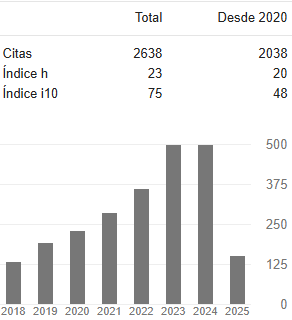Estudio de la viabilidad del Lactobacillus casei en jugo de naranja (Citrus sinensis) adicionado con vitamina C, Calcio y oligofructosa
DOI:
https://doi.org/10.31908/19098367.547Palabras clave:
naranja, jugo, bacterias probióticasResumen
Se utilizó la Naranja Valencia para producir un jugo enriquecido con bacterias probióticas (Lactobacilos casei). Se evaluó la concentración óptima de estabilizante realizando un berrido con tres tipos de gomas (Xantan, CMC, y pectina), evaluado mediante un arreglo factorial 33. Posteriormente se adicionó el microorganismo a tres concentraciones diferentes (0,4 -0,5 y 0,6 Mc – Farland) y los compuestos fisiológicamente activos (Calcio y vitamina C) en un 20% del valor diario recomendado según la resolución 333 de 2011 del ministerio de protección social. Los resultados mostraron que se debe adicionar Pectina 0.02 %, CMC 0.015 % y Xantan 0.014 %. El análisis de la concentración de microorganismos durante el tiempo de almacenamiento muestra que la concentración inicial aumentó hasta llegar a 7.21* 109 UFC, y el pH permaneció constante desde el día 15 hasta el 20 en 3.8.
Descargas
Referencias
Ferrari, Carlos K.B. 2007. Functional foods and physical activities in health promotion of aging people, Maturitas, 58(4): 327-339.
Assmann, G. P.; Buono, A.; Daniele, E.; Della Valle, E.; Farinaro, G.; Ferns, V.; Krogh, D.; Kromhout, L.; Masana, J.; Merino, G.; Misciagna, S.; Panico, G.; Riccardi, A.A.; Rivellese, F.; Rozza, F.; Salvatore, V.; Salvatore, S;. Stranges, M.; Trevisan, B. y Trimarco, C. 2014. Functional foods and cardiometabolic diseases: International Task Force for Prevention of Cardiometabolic Diseases, Nutrition, Metabolism and Cardiovascular Diseases. 24 (12):1272-1300.
Davari, S.; Talaei, S.A y Alaei, M. 2013. Probiotics treatment improves diabetes-induced impairment of synaptic activity and cognitive function: Behavioral and electrophysiological proofs for microbiome–gut–brain axis, Neuroscience. 240 (14): 287-296.
Machairas Nikolaos, Aikaterini Pistiki, Dionyssia-Irini Droggiti, Marianna Georgitsi, Nikolaos Pelekanos, Georgia Damoraki, Grigorios Kouraklis, Evangelos J. Giamarellos-Bourboulis. 2015. Pre-treatment with probiotics prolongs survival after experimental infection by multidrug-resistant Pseudomonas aeruginosa in rodents: An effect on sepsis-induced immunosuppression, International Journal of Antimicrobial Agents, Available online.
Serban Daniela Elena. 2014. Gastrointestinal cancers: Influence of gut microbiota, probiotics and prebiotics, Cancer Letters. 345(2): 258-270.
Karimi, R. A.M.; Mortazavian, M.; Karami, M. 2012. Incorporation of Lactobacillus casei in Iranian ultrafiltered Feta cheese made by partial replacement of NaCl with KCl, Journal of Dairy Science. 95(8): 4209-4222.
Chaikham Pittaya, Arunee Apichartsrangkoon, Wachira Jirarattanarangsri, Tom Van de Wiele. 2012. Influence of encapsulated probiotics combined with pressurized longan juice on colon microflora and their metabolic activities on the exposure to simulated dynamic gastrointestinal tract, Food Research International. 49(1): 133-142.
Awaisheh S.S.; Haddadin, M.S.Y.; Robinson, R.K. 2005. Incorporation of selected nutraceuticals and probiotic bacteria into a fermented milk, International Dairy Journal, 15 (11): 1184-1190.
Tripathi M.K. y Giri, S.K. 2014. Probiotic functional foods: Survival of probiotics during processing and storage, Journal of Functional Foods. 9: 225-241.
Quintero, V. D.; Giraldo G. y Cortes M. 2012. Evaluación de viscosidad y color en la pulpa de mango común (Mangifera indica l) tratada enzimáticamente. Temas agrarios. Facultad de Ciencias. 17 (2): 66 – 76.
Fernández-Vázquez, R.; Stinco, C. M.; Hernanz, D. J. Heredia F. y Vicario, I. M. 2013. Colour training and colour differences thresholds in orange juice, Food Quality and Preference. 30(2): 320-327.
Legua, J.B.; Forner, F.; Hernández, M.A. y Forner-Giner, M. 2013. Physicochemical properties of orange juice from ten rootstocks using multivariate analysis, Scientia Horticulturae, 160 (27): 268-273.
Magerramov, M.A.; Abdulagatov, A.I.; Azizov, N.D. y Abdulagatov I.M. 2007. Effect of temperature, concentration, and pressure on the viscosity of pomegranate and pear juice concentrates, Journal of Food Engineering. 80(2): 476-489.
Vervoort, L.; Van der Plancken, I.; Grauwet, T.; Rian, A.H.; Timmermans, H. C.; Mastwijk, A. M.; Matser, M. E.; Hendrickx, A. 2011. Comparing equivalent thermal, high pressure and pulsed electric field processes for mild pasteurization of orange juice: Part II: Impact on specific chemical and biochemical quality parameters, Innovative Food Science & Emerging Technologies. 12(4): 466-477.
Abd-Elhady M. 2014. Effect of citric acid, calcium lactate and low temperature prefreezing treatment on the quality of frozen strawberry, Annals of Agricultural Sciences. 59(1): 69-75.
Moraga M.J.; Moraga, G. Fito, P.J.; Martínez-Navarrete, N. 2009. Effect of vacuum impregnation with calcium lactate on the osmotic dehydration kinetics and quality of osmodehydrated grapefruit, Journal of Food Engineering. 90(3): 372-379.
Gómez-López V.M.; Orsolani, L.; Martínez-Yépez, A.; Tapia, M.S. 2010. Microbiological and sensory quality of sonicated calciumadded orange juice, LWT - Food Science and Technology. 43(5): 808-813.
Cortés, C.; Esteve, M. J. y Frígola, A. 2008. Color of orange juice treated by High Intensity Pulsed Electric Fields during refrigerated storage and comparison with pasteurized juice, Food Control. 19(2): 151-158.
Hartyáni P.; István D.; Zsuzsanna C.; Dávid-Balázs K.; Tóth-Markus M. y Sass-Kiss, A. 2011. Physical–chemical and sensory properties of pulsed electric field and high hydrostatic pressure treated citrus juices, Innovative Food Science & Emerging Technologies. 12(3): 255-260.
Hyun M. y Byoungseung Y. 2015. Rheological Characteristics of Cold Thickened Beverages Containing Xanthan Gum–Based Food Thickeners Used for Dysphagia Diets, Journal of the Academy of Nutrition and Dietetics. 115(1): 106-111.
Tiwari, B.K.; O’ Donnell, C.P.; Muthukumarappan, K. y Cullen, P.J. 2009. Ascorbic acid degradation kinetics of sonicated orange juice during storage and comparison with thermally pasteurised juice, LWT - Food Science and Technology. 42(3): 700-704.
Guignon B.; Cristina A.; Sanz, P. y Otero L. 2012. Orange juice pvT-properties for high-pressure processing and modeling purposes: Importance of soluble solids concentration, Food Research International. 46(1): 83-91.
Soares Leite T. P.; Augusto, E.D. y Cristianini, M. 2014. The use of high pressure homogenization (HPH) to reduce consistency of concentrated orange juice (COJ), Innovative Food Science & Emerging Technologies. 26: 124-133.
Croak S. y Corredig, M. 2006. The role of pectin in orange juice stabilization: Effect of pectin methylesterase and pectinase activity on the size of cloud particles, Food Hydrocolloids. 20(7): 961-965.
Mirhosseini H.; Chin P. T.; Nazimah S.A.; Hamid, S.; Yusof, B. y Huey C. 2009. Characterization of the influence of main emulsion components on the physicochemical properties of orange beverage emulsion using response surface methodology, Food Hydrocolloids. 23(2): 271-280.
Paquet É.; Raza H.; Laurent F.; Makhlouf, J.; Lemieux, S.; Turgeon, S. 2014. Effect of processing treatments and storage conditions on stability of fruit juice based beverages enriched with dietary fibers alone and in mixture with xanthan gum, LWT - Food Science and Technology. 55(1): 131-138.
Remini H.; Mertz, C.; Belbahi, A.; Achir, N.; Dornier, M.; Madani, K. 2015. Degradation kinetic modelling of ascorbic acid and colour intensity in pasteurised blood orange juice during storage, Food Chemistry. 173: 665-673.
Meléndez-Martínez A.J.; Gómez-Robledo L.; Melgosa, M.; Vicario, I.M. Heredia, F.J. 2011. Color of orange juices in relation to their carotenoid contents as assessed from different spectroscopic data, Journal of Food Composition and Analysis. 24(6): 837-844.
Sopade P.A., Halley, P.J. Cichero, J.A.Y. Ward, L.C. Liu, J. Varliveli, S. 2008. Rheological characterization of food thickeners marketed in Australia in various media for the management of dysphagia. III. Fruit juice as a dispersing medium, Journal of Food Engineering. 86(4): 604-615.
Colombo Pimentel T.; Scaramal M.; Prudencio, S. 2014. Probiotic clarified apple juice with oligofructose or sucralose as sugar substitutes: Sensory profile and acceptability, LWT - Food Science and Technology, Available online.
Furtado de Oliveira R. y Bolini H. 2014. Different sweeteners in passion fruit juice: Ideal and equivalent sweetness, LWT - Food Science and Technology, Available online.
Brown A. W.; Bohan B.; Onken, K.; Beitz, D. 2011. Short-term consumption of sucralose, a nonnutritive sweetener, is similar to water with regard to select markers of hunger signaling and shortterm glucose homeostasis in women, Nutrition Research. 31(12): 882-888.
Ferrer I. y Thurman, M. 2010. Analysis of sucralose and other sweeteners in water and beverage samples by liquid chromatography/ time-of-flight mass spectrometry, Journal of Chromatography A. 1217(25): 4127-4134.
Basu S.; Shivhare, U.S.; Singh, T.V. 2013. Effect of substitution of stevioside and sucralose on rheological, spectral, color and microstructural characteristics of mango jam, Journal of Food Engineering. 114(4): 465-476.
Yuki N.; Koichi W.; Akito.; Yoko.; Ryuichiro T.; Makoto O.; Masami M. 1999. Survival of a probiotic, Lactobacillus casei strain Shirota, in the gastrointestinal tract: Selective isolation from faeces and identification using monoclonal antibodies, International Journal of Food Microbiology. 48(1): 51-57.
Carbonell J.V.; Tárrega, A.; Gurrea, M.C.; Sentandreu, E. 2011. Chilled orange juices stabilized by centrifugation and differential heat treatments applied to low pulp and pulpy fractions, Innovative Food Science & Emerging Technologies. 12(3): 315-319.
Martinez P.; Martín-Belloso, O. 2007. Effects of high intensity pulsed electric field processing conditions on vitamin C and antioxidant capacity of orange juice and gazpacho, a cold vegetable soup, Food Chemistry. 102(1): 201-209.
Martín-Diana A. B.; Rico, D.; Barat, J.M.; Barry-Ryan, C. 2009. Orange juices enriched with chitosan: Optimisation for extending the shelf-life, Innovative Food Science & Emerging Technologies. 10(4): 590-600.
Tahiri I.; Makhlouf, J.; Paquin, P. y Fliss, I. 2006. Inactivation of food spoilage bacteria and Escherichia coli O157:H7 in phosphate buffer and orange juice using dynamic high pressure, Food Research International. 39(1): 98-105.
Descargas
Publicado
Número
Sección
Licencia
Derechos de autor 2019 Entre Ciencia e Ingeniería

Esta obra está bajo una licencia internacional Creative Commons Atribución-NoComercial 4.0.



















